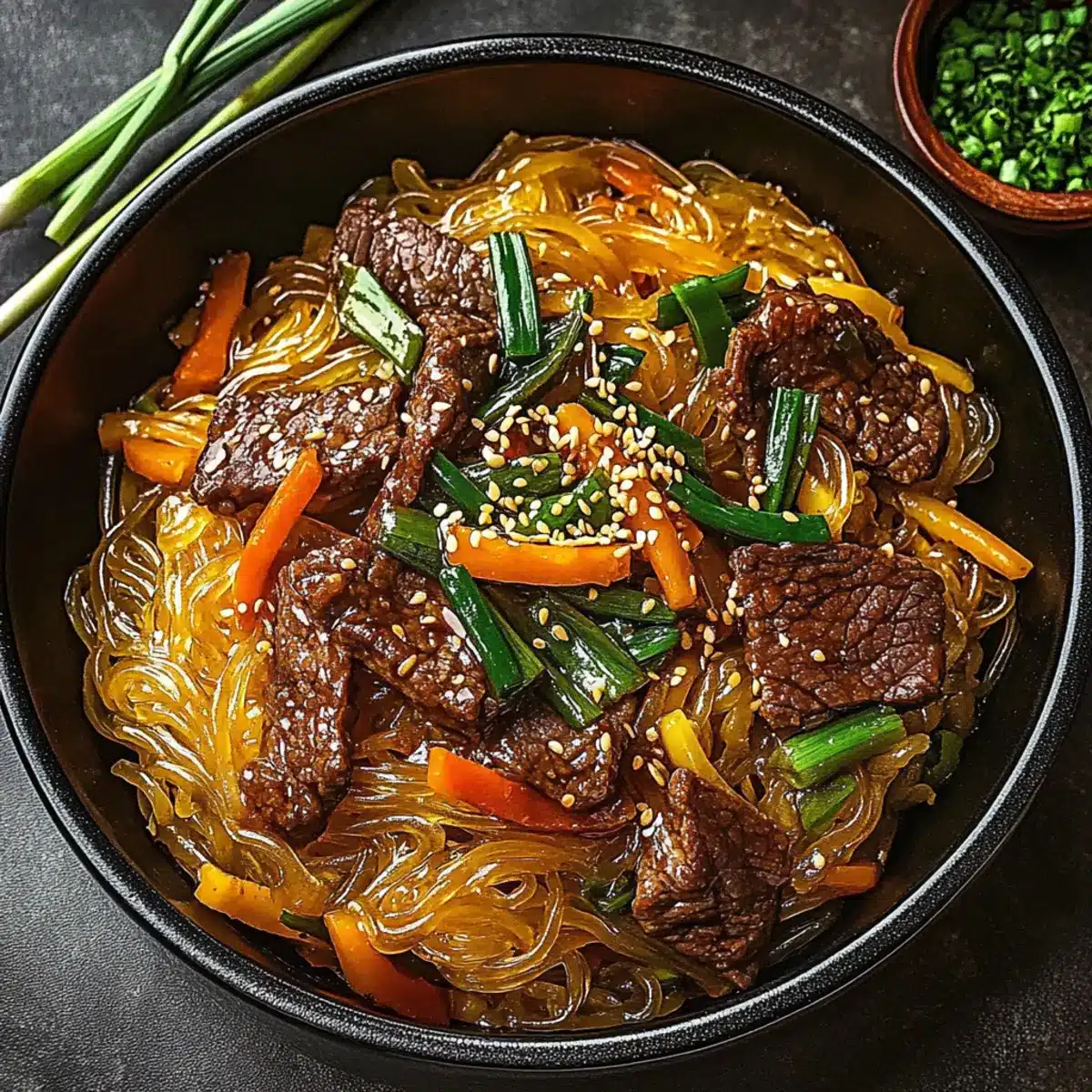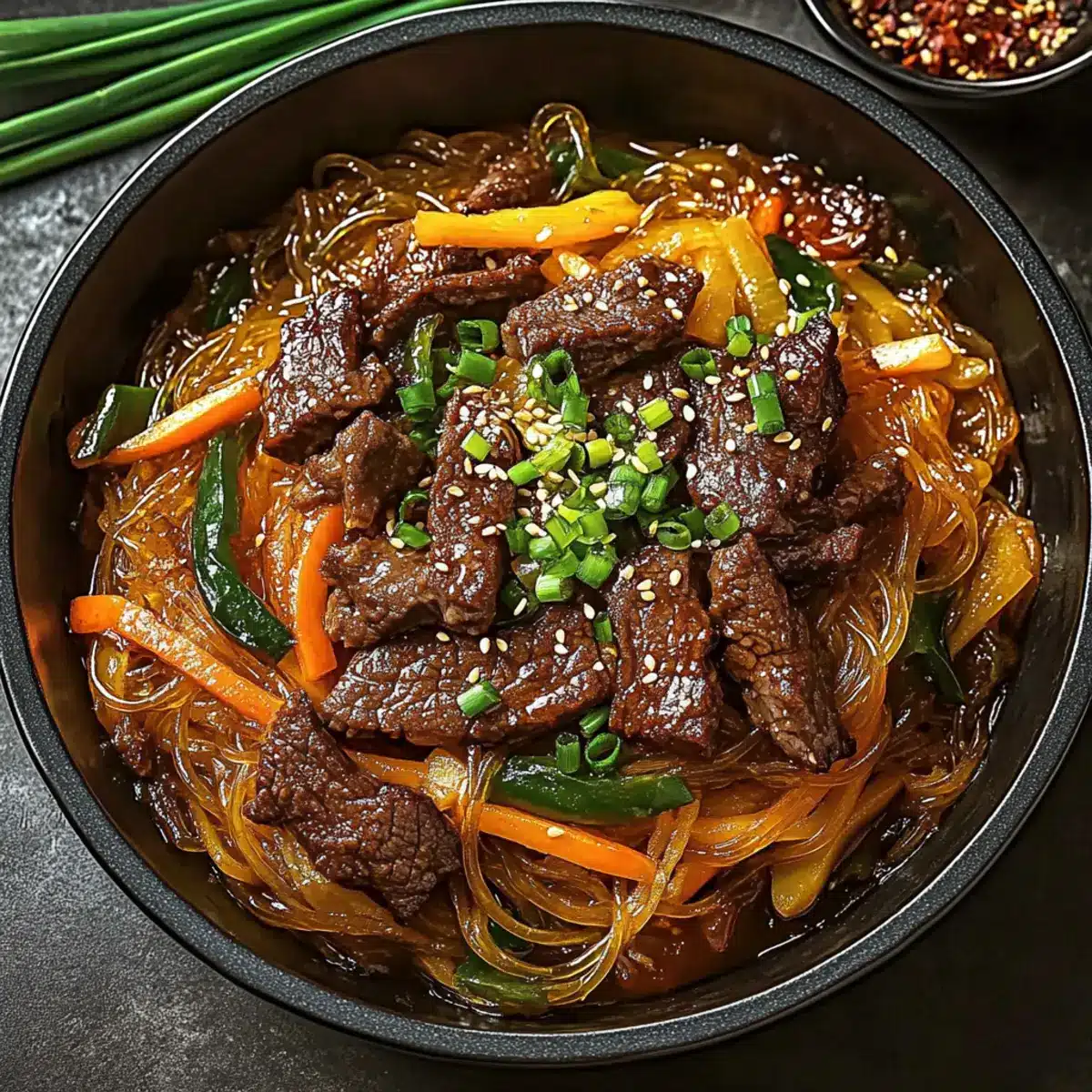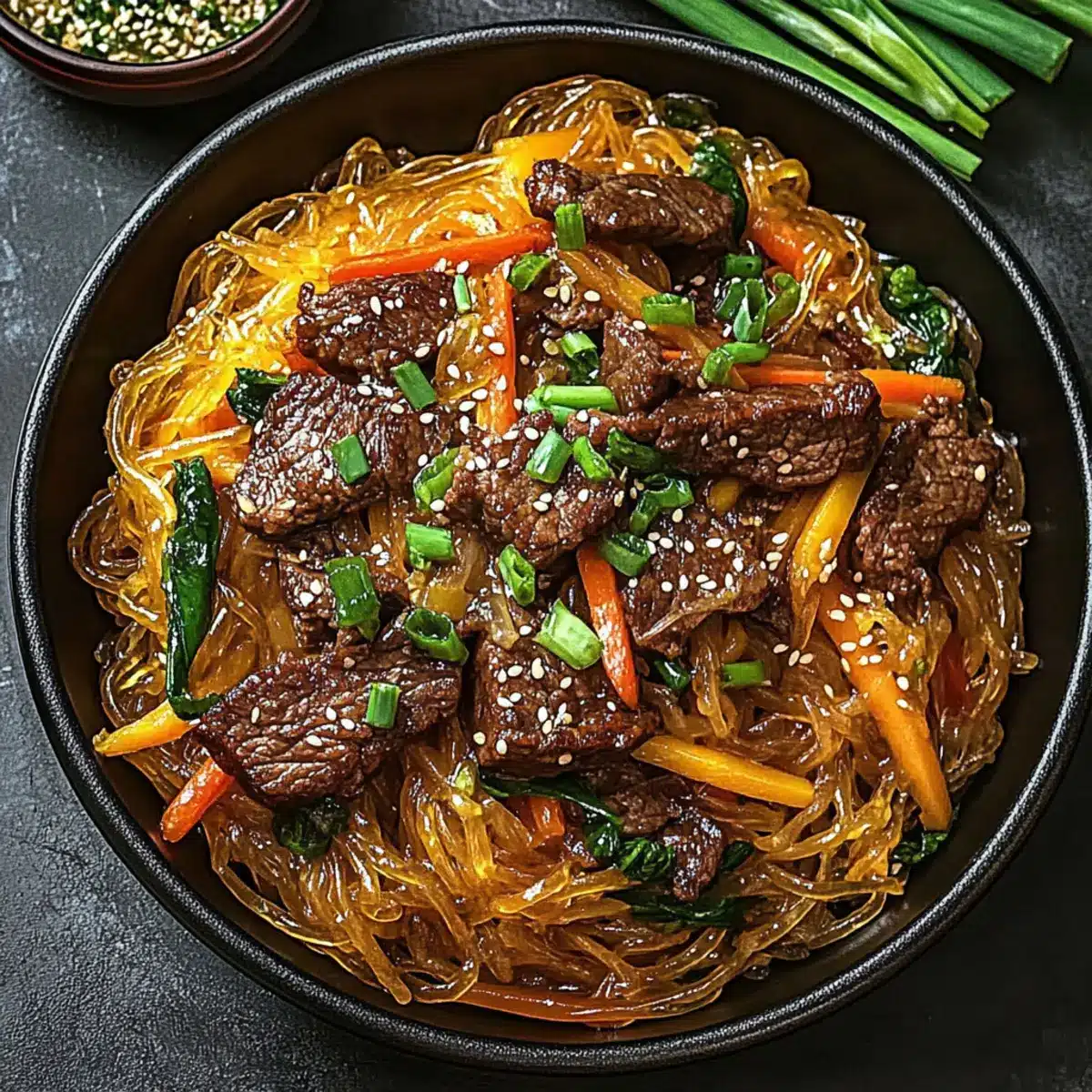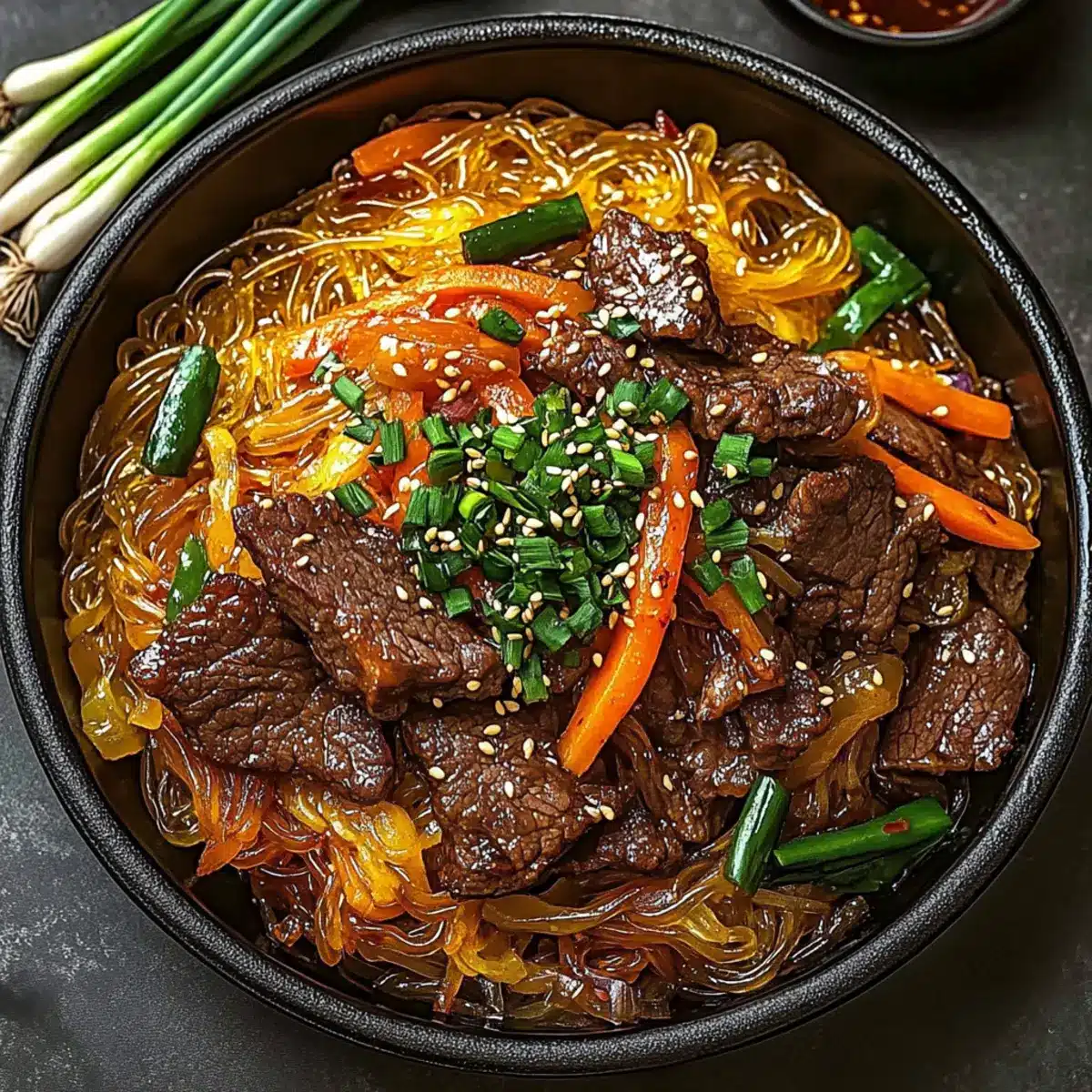As I stood in my kitchen, the vibrant colors of fresh vegetables caught my eye, instantly reminding me of my travels through Korea. Today, I’m excited to share my take on Japchae, a beloved Korean sweet potato noodle stir-fry that captures the essence of comfort food while allowing for endless customization. These chewy, gluten-free noodles are mixed with tender beef (or your choice of protein), seasonal veggies, and a luscious soy-sesame glaze that brings everything together beautifully. Not only is Japchae a feast for the eyes, but it’s also a quick and satisfying meal that fits effortlessly into a busy weeknight or a special occasion. The balance of textures and flavors ensures it’ll be a hit with family and friends alike. Ready to whip up your own bowl of deliciousness? Let’s dive into this delightful recipe!

Why is Japchae a Must-Try?
Flavorful Fusion: Japchae brings together the sweet aroma of sweet potato noodles with savory beef and fresh veggies for an unforgettable flavor experience.
Versatile & Customizable: Tailor this dish to your liking by swapping proteins or adding your favorite seasonal vegetables—perfect for clearing out your fridge!
Quick & Easy: With minimal prep and cooking time, you can enjoy a wholesome meal without hours in the kitchen.
Nutrient-Packed: Loaded with vitamins and fiber, this dish not only tastes great but also supports a healthier lifestyle. Don’t forget to check out my easy guide on how to make perfect stir-fried vegetables to enhance your Japchae even more!
Crowd-Pleaser: Serve it at family gatherings or dinner parties; trust me, it will impress everyone at the table!
Japchae Ingredients
For the Noodles
• Sweet Potato Glass Noodles (Dangmyeon) – These are the star of the dish, providing that beloved chewy texture; don’t worry, they’re gluten-free!
For the Stir-Fry
• Beef (e.g., sirloin) – This adds a rich and hearty flavor to your Japchae; feel free to substitute with chicken or tofu for a delicious vegetarian option.
• Vegetables (e.g., carrots, bell peppers, spinach, onions) – These add vibrant color and crunch; get creative and use any fresh veggies you have on hand for added nutrition.
For the Sauce
• Soy Sauce – Key for seasoning, giving depth to the dish; opt for low-sodium soy sauce for a healthier twist.
• Sesame Oil – This ingredient adds a beautiful nutty aroma and flavor; if you’re in a pinch, you can use olive oil, but the taste will differ a bit.
For Garnish
• Green Onions – Sprinkle these on top for a fresh finishing touch; chives make a great substitute in a hurry.
Step‑by‑Step Instructions for Japchae
Step 1: Soak the Noodles
Begin by bringing a large pot of water to a boil. Add the sweet potato glass noodles and let them soak for 20–30 minutes until they soften and become pliable. Once done, drain them well and set aside; they should be glossy and tender but not overly mushy.
Step 2: Prepare the Ingredients
While the noodles soak, take the time to slice your beef and vegetables into thin strips. Aim for uniform sizes to ensure even cooking; think vibrant carrots, crisp bell peppers, and fresh spinach. Set these prepared ingredients aside, keeping them organized for easy access during the stir-fry process.
Step 3: Stir-Fry the Beef
In a large, non-stick skillet or wok, heat 1-2 tablespoons of oil over medium heat. Once hot, add the sliced beef and stir-fry for about 3–5 minutes until it’s browned and cooked through, with a lovely sear. When ready, remove the beef from the pan and set it aside to keep it tender.
Step 4: Cook the Vegetables
In the same pan, toss in the prepared vegetables and stir-fry for 4–5 minutes. Cook until the vegetables are bright and just tender, maintaining a little crunch for texture. Stir continuously to ensure even cooking and prevent sticking, allowing their colors to pop.
Step 5: Combine the Ingredients
Add the drained noodles and cooked beef back into the pan with the vegetables. Drizzle soy sauce and sesame oil over the mixture, tossing everything together for 2-3 minutes. Stir continuously until the noodles are heated through and coated evenly with the savory sauce for the perfect assembly of flavors in your Japchae.
Step 6: Serve and Garnish
Once thoroughly mixed and heated, transfer the Japchae to a serving platter or individual bowls. Garnish with finely sliced green onions for a fresh touch. This beautiful dish is now ready to enjoy, visually appealing and bursting with flavors that your loved ones will cherish!

Make Ahead Options
These Japchae noodles are perfect for meal prep enthusiasts! You can prepare the sweet potato glass noodles up to 24 hours in advance by soaking them in water, then draining them and storing them in an airtight container in the refrigerator. The sliced vegetables and beef can also be prepped up to 3 days ahead; simply store them separately in the fridge to maintain freshness and flavor. When you’re ready to serve, just stir-fry the beef and vegetables together, add the noodles and sauce, and heat everything through—ensuring that your Japchae is just as delicious as when freshly made. This way, you’ll have a wholesome meal ready in no time on those busy nights!
What to Serve with Japchae?
Imagine a vibrant spread of flavors and textures that elevate your homemade Japchae experience, making every bite a celebration.
- Kimchi: This iconic Korean side dish adds a spicy, tangy kick that perfectly complements the mild sweetness of the noodles.
- Crispy Tempura: Light and crunchy, tempura vegetables or shrimp offer a delightful contrast to the chewy texture of Japchae, creating a diverse dining experience.
- Steamed Rice: A bowl of fluffy white or brown rice serves as a soothing backdrop for the bold flavors of Japchae, allowing each bite to shine.
To round out your meal, consider pairing Japchae with a warm miso soup. The umami-rich broth adds warmth and depth, making it an ideal side for this flavorful stir-fry. Adding a refreshing cucumber salad can also enhance the meal, balancing the richness with its crisp texture and tangy dressing.
- Soju: A smooth Korean spirit, it perfectly complements the flavors of Japchae while inviting a joyful toast to your culinary adventure!
Japchae: Customizable Combinations
Feel free to get creative and make this Japchae recipe truly yours with these exciting variations and substitutions!
- Protein Swap: Replace the beef with diced chicken, shrimp, or tofu for a delightful twist, ensuring every bite is packed with flavor.
- Vegetable Medley: Incorporate seasonal vegetables like zucchini, mushrooms, or snap peas to mix things up, adding color and nutrients.
- Spicy Kick: Add gochujang or crushed red pepper flakes for a fiery burst of heat that elevates your Japchae to new flavor heights.
- Noodle Alternatives: If you’re looking to switch up the texture, try using rice noodles or even zucchini noodles for a fun, gluten-free option.
- Flavor Boost: Marinate your protein in soy sauce and garlic before sautéing for a deeper and richer flavor experience.
- Herb Enhancement: Sprinkle in fresh herbs like cilantro or basil before serving to add a refreshing note that brightens the dish.
- Nutty Delight: Toss in some toasted sesame seeds as a finishing touch for an extra crunch and a nutty aroma that pairs beautifully with the noodles.
- Vegetarian Variation: Opt for mushroom-based sauces to replace traditional soy sauce for a unique umami flavor, enhancing the depth of your dish.
Feel inspired to indulge in your own Japchae adventure? For more delicious vegetable ideas, check out my guide on the art of stir-frying vegetables!
Storage Tips for Japchae
Fridge: Store leftover Japchae in an airtight container for up to 3 days, ensuring freshness and preventing moisture absorption.
Freezer: For longer storage, freeze Japchae in individual portions in freezer-safe containers for up to 3 months. Thaw in the fridge overnight before reheating.
Reheating: Gently reheat in a skillet over medium heat, adding a splash of water or oil to prevent noodles from drying out or becoming mushy.
Room Temperature: Avoid leaving Japchae out at room temperature for more than 2 hours to keep it safe and delicious.
Expert Tips for Perfect Japchae
• Noodle Cooking: Ensure noodles are soaked just until tender; over-soaking can lead to mushiness and ruin the texture of your delicious Japchae.
• Quality Ingredients: Use fresh, high-quality vegetables and protein for the best flavor; this dish shines when vibrant, seasonal ingredients are at the forefront.
• Flavor Balance: Start with less soy sauce and add more gradually to avoid overpowering the dish; this way, you can control the saltiness to suit your taste.
• High Heat Stir-Fry: Use high heat when cooking to achieve that beautiful sear on the beef and keep vegetables crisp; this enhances both textures and flavors.
• Add Spice Carefully: If you’re opting for a spicy version, start with a small amount of gochujang; remember, you can always add more heat, but it’s hard to take it away!

Japchae (Korean Sweet Potato Noodle Stir-Fry) Recipe FAQs
How do I choose the best sweet potato glass noodles?
When selecting sweet potato glass noodles, look for brands that list “dangmyeon” as the main ingredient, ensuring authenticity and quality. The noodles should appear translucent and slightly shiny, with no visible dark spots or damage. Always check the expiration date for freshness!
How long can I store leftover Japchae in the fridge?
Leftover Japchae can be stored in an airtight container in the refrigerator for up to 3 days. Make sure the dish is cooled down before placing it in the fridge to maintain its texture and flavor. When ready to enjoy it again, gently reheat it on the stove to revive its deliciousness.
Can I freeze Japchae?
Absolutely! To freeze Japchae, allow it to cool completely, then portion it into freezer-safe containers or bags, ensuring to remove as much air as possible. It can be frozen for up to 3 months. When ready to eat, thaw it overnight in the fridge, then reheat gently to maintain the texture of your noodles.
What should I do if the noodles become mushy?
If your noodles end up mushy, it may be because they were overcooked. To avoid this in the future, ensure you only soak the sweet potato noodles for about 20-30 minutes until they are tender but still slightly firm. If you’ve already made mushy noodles, you might try mixing them into a soup to salvage the dish!
Are there any dietary considerations for this recipe?
Yes! Japchae is gluten-free due to the use of sweet potato glass noodles, making it a great option for those with gluten sensitivities. If you’re serving it to pets, keep in mind that while plain noodles are generally safe, it’s best to avoid any seasoned portions, especially those with soy sauce or oils that may not be suitable for them. Always check for any allergies related to your choice of protein or vegetables!
What vegetables can I substitute in my Japchae?
You can customize your Japchae by using a variety of vegetables. Excellent options include zucchini, mushrooms, or snap peas, depending on what you have on hand. Just be sure to slice them into thin strips for even cooking, and aim to use vibrant, seasonal produce for the best flavor and nutrition!

Japchae: Irresistible Korean Noodles You’ll Love to Make
Ingredients
Equipment
Method
- Bring a large pot of water to a boil. Add the sweet potato glass noodles and soak for 20–30 minutes until soft. Drain and set aside.
- Slice your beef and vegetables into thin strips for even cooking. Set aside.
- In a large skillet or wok, heat 1-2 tablespoons of oil over medium heat. Add the sliced beef and stir-fry for 3–5 minutes until browned. Remove beef and set aside.
- In the same pan, stir-fry the vegetables for 4–5 minutes until bright and just tender. Stir continuously.
- Combine drained noodles and cooked beef back in the pan. Drizzle soy sauce and sesame oil over, tossing everything together for 2-3 minutes until heated and coated evenly.
- Transfer to a serving platter or individual bowls. Garnish with finely sliced green onions. Serve immediately.

Leave a Reply